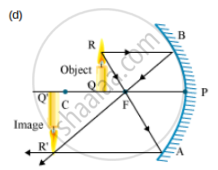Advertisements
Advertisements
प्रश्न
A student wants to project the image of a candle flame on a screen 60 cm in front of a mirror by keeping the flame at a distance of 15 cm from its pole.
(a) Write the type of mirror he should use.
(b) Find the linear magnification of the image produced.
(c) What is the distance between the object and its image?
(d) Draw a ray diagram to show the image formation in this case.
उत्तर
(a) He should use a concave mirror, as it forms a real image on the same side of the mirror.
(b) Object distance, u = -15 cm
Image distance, v = - 60 cm
`"Magnification, "m=-v/u=-((-60))/((-15))=-4" cm"`
The minus sign in magnification shows that the image formed is real and inverted.
(c) The image is formed at a distance of 45 cm from the object.

In this case, the image is formed beyond the centre of curvature. This image is real, inverted and enlarged.
APPEARS IN
संबंधित प्रश्न
At what distance from a concave lens of focal length 20 cm, should a 6 cm tall object be placed so that it forms an image at 15 cm from the lens ? Also determine the size of the image formed.
A student was asked by his teacher to find the image distance for various object distance in case of a given convex lens. He performed the experiment with all precautions and noted down his observations in the following table:
| S. No. |
Object distance (cm) |
Image distance (cm) |
| 1 | 60 | 15 |
| 2 | 48 | 16 |
| 3 | 36 | 21 |
| 4 | 24 | 24 |
| 5 | 18 | 36 |
| 6 | 16 | 48 |
After checking the observations table the teacher pointed out that there is a mistake in recording the image distance in one of the observations. Find the serial number of the observations having faulty image distance.
(A) 2
(B) 3
(C) 5
(D) 6
An object is held 20 cm away from a converging lens of focal length 10 cm. Find the position of the image formed.
Linear magnification produced by a concave mirror may be:
(a) less than 1 or equal to 1
(b) more than 1 or equal than 1
(c) less than 1, more than 1 or equal to 1
(d) less than 1 or more than 1
Magnification produced by a convex mirror is always:
(a) more than 1
(b) less than 1
(c) equal to 1
(d) more or less than 1
A concave mirror produces magnification of +4. The object is placed:
(a) at the focus
(b) between focus and centre of curvature
(c) between focus and pole
(d) between the centre of curvature
In order to obtain a magnification of, −0.6 (minus 0.6) with a concave mirror, the object must be placed:
(a) at the focus
(b) between pole and focus
(c) between focus and centre of curvature
(d) beyond the centre of curvature
Give a scientific reason.
Simple microscope is used for watch repairs.
What do you understand by the term magnification?
The lens of the eye is flattened when looking at nearby objects.
